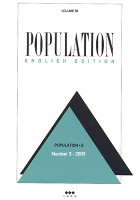
Population 2003 n° 3
2003
The Fertility of Palestinian Women in Gaza, the West Bank, Jordan and Lebanon - M. Khawaja
- Wilhelm Lexis: The Normal Length of Life as an Expression of the "Nature of Things" - J. Véron, J.-M. Rohrbasser
- Population Patterns and Household Trajectories in the Residential Milieu: the Example of the Seine-Saint-Denis - J.-P. Lévy
Particularities of the Population of Quebec
- The Transmission Probabilities of Founder Genes in Five Regional Populations of Quebec - M. Tremblay, J. Arsenault, É. Heyer
Short paper
- Demographic Determinants of the Sex Ratio at Birth in the Saguenay Population, Quebec - M. Tremblay, H. Vezina, L. Houde
The Fertility of Palestinian Women in Gaza, the West Bank, Jordan and Lebanon
Khawaja Marwan
This article presents a largely descriptive account of reproduction among Palestinian populations in four settings: the West Bank, the Gaza Strip, Jordan and Lebanon. Trends and differentials in fertility and contraceptive use are described using high-quality household survey data. Comparisons are made between the refugee and non-refugee populations. Issues related to family reproduction among Palestinian refugees are of particular policy concern because the demographic future of the Palestinians is largely determined by fertility. The findings show that refugee status can no longer be considered a fundamental distinguishing feature of Palestinian reproductive behaviour. On the one hand, variations in fertility-related indicators across countries far exceed those between refugees and non-refugees within the same setting. On the other hand, the refugee population has become more differentiated over the years, with those residing outside the camps generally having a different reproductive behaviour from their counterparts in camps. Thus, the camp versus non-camp distinctions are still relevant everywhere, notwithstanding the legal or circumstantial situation of the refugees residing in the various settings.
Wilhelm Lexis: The Normal Length of Life as an Expression of the "Nature of Things"
Véron Jacques, Rohrbasser Jean-Marc
At the first International Congress of Demography held in Paris in 1878, the German statistician Wilhelm Lexis argued for the notion of a normal length of human life governed by a law of nature. His conception was based on Quetelet’s "average man" and the law of normal distribution of errors formulated by Laplace and Gauss.The normal length of life, which differs from the average length of life, is, according to Lexis, a "true value" characteristic of the mortality of the human species.Lexis classifies ages at death into three groups, of which the most important is "the normal group". He seeks to define its boundaries by distinguishing normal deaths from "premature" ones. Normal mortality is then described by three values: normal age at death, the proportion of deaths included in the normal group, and probable error.The discussions generated by Lexis’s paper, most notably Bertillon’s remarks on infant mortality, reveal distinct perceptions of the mortality process. A few years later, specialists such as Bodio, Perozzo, Levasseur, and Pareto took up the theory and method of Lexis, acknowledging the originality of his mathematical and statistical analysis of mortality, though not endorsing his hypothesis of a law of nature.
Population Patterns and Household Trajectories in the Residential Milieu: the Example of the Seine-Saint-Denis
Lévy Jean-Pierre
This article examines the processes underlying changes in the residential population of the Seine-Saint-Denis department (a suburban district to the north and east of Paris, containing 500,000 households) from three points of view: 1) the residential logics of different social groups, 2) the effects of the housing supply structure and 3) the effects of the social markers attributed to the different local areas.
Data from the 1990 Census are used to establish housing categories containing housing types whose residents have similar characteristics. These categories are then ranked and interpreted using an index of socio-residential status, whose spatial variations indicate the influence of the social markers of the communes on the population (residential areas). These markers can derive from the composition of their housing stock (housing zones) or from their geographical situation (local effects).
These typologies are then used to interpret the residential mobility of households who moved into a dwelling in the Seine-Saint-Denis in 1994. Data pertaining to the 1,568 surveyed households are analysed in three ways: to determine the residential trajectories of households; to shed light on the locational choices of households, and on the scope for action and constraints shaping their decision; and current residential histories are used as an indicator of change in local populations.
Particularities of the population of Quebec
The Transmission Probabilities of Founder Genes in Five Regional Populations of Quebec
Tremblay Marc, Arsenault Julie, Heyer Évelyne
Certain rare hereditary diseases have an unusually high incidence in the population of Quebec. The deleterious genes associated with these disorders were probably introduced in the seventeenth century by immigrants whose descendants are the ancestors of a large part of the modern population of Quebec. The goal of this study is to measure the differential transmission of the genes of founders at the origin of five regional populations of Quebec (Beauce, Charlevoix, Rimouski, Saguenay and Terrebonne). Using gene dropping, 50,000 simulations were performed with an initial sample of 756 ascending genealogies. The results show certain founders to have a non-negligible probability of having transmitted their genes to at least 5% of the population in the Charlevoix and Saguenay regions. The probabilities of reaching carrier frequencies between 1% and 5% (this is the frequency level at which several recessive genes in the population are found) are much higher, and for a larger number of founders in the five regions. Nevertheless, the observed differences between the probabilities obtained for the founders of each region suggest distinct trajectories in the transmission of founder genes, attributable to differential migratory and reproductive behaviour among the descendants of the founders.
Prix TTC : 20,00 €

